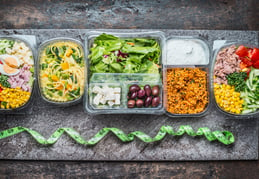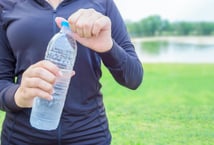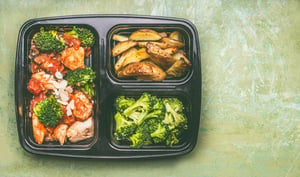 In plastics packaging, particularly food packaging, initiatives to cut down on the amount of single-use plastics as a means of reducing waste has sent brand owners and converters in search of packaging designs and solutions that make re-using the packaging, rather than recycling or throwing it away, a feasible option. Instead of sending the package straight to the recycling bin, the container can used again as a food storage container extending the life of the packaging container, and resulting in less waste to landfill. While this is true, what isn’t mentioned, however, is that not all plastics are safe to reuse.
In plastics packaging, particularly food packaging, initiatives to cut down on the amount of single-use plastics as a means of reducing waste has sent brand owners and converters in search of packaging designs and solutions that make re-using the packaging, rather than recycling or throwing it away, a feasible option. Instead of sending the package straight to the recycling bin, the container can used again as a food storage container extending the life of the packaging container, and resulting in less waste to landfill. While this is true, what isn’t mentioned, however, is that not all plastics are safe to reuse.
Meanwhile, consumers are taking this message to heart. In fact, a ShopSmart survey reports that about half of women shoppers reuse or repurpose food packaging as food storage containers, which could present a potential risk for bacterial contamination in containers that are designed for single-use applications. To help you make an more informed decision when it comes to the safety of your food packaging, we’ve provided a breakdown of plastics commonly encountered in commercially packaged food products, and whether or not they are safe to reuse again after the intended use:
 PET: If you’ve had a drink out of plastic water bottle, you’ve used a PET bottle. PET is the most common plastic material used for consumable bottled liquids, such as soft drinks and bottled water, condiments, and other food products. It’s also used extensively in rigid food packaging applications due to its attractive price point and excellent clarity in applications that require it. According to the American Chemistry Council (ACC), these bottles and packages are okay to use again after a thorough washing. However, it is important to note clearly on the package the heat restrictions of this material, as PET containers may warp, contaminate or affect the taste and odor of food after undergoing high heat conditions such as the microwave or dishwasher.
PET: If you’ve had a drink out of plastic water bottle, you’ve used a PET bottle. PET is the most common plastic material used for consumable bottled liquids, such as soft drinks and bottled water, condiments, and other food products. It’s also used extensively in rigid food packaging applications due to its attractive price point and excellent clarity in applications that require it. According to the American Chemistry Council (ACC), these bottles and packages are okay to use again after a thorough washing. However, it is important to note clearly on the package the heat restrictions of this material, as PET containers may warp, contaminate or affect the taste and odor of food after undergoing high heat conditions such as the microwave or dishwasher.
- High Density Polyethylene (HDPE): HDPE is commonly used in food packaging in large bottle applications, such as milk bottles or juice bottles. Items such as yogurt and margarine tubs can also be made out of HDPE. The recommendation of the ACC is that HDPE plastic packaging is safe to reuse after the original contents has been consumed.
- PVC: For PVC, the general consensus seems to be to avoid it entirely when it comes to food packaging applications, which is probably why it we typically see it more in consumer goods-type applications. This is because the manufacture of PVC creates dioxin, a potentially harmful carcinogen. That being said, food packaging applications produced from PVC still do exist, although a concerted effort is being made to phase out this material in this market. So in a few words, stay away from re-using a PVC container for food, and do not use a PVC container used to package other goods for food storage.
- Low Density Polyethylene (LDPE): LDPE plastics can often be found in wrapper applications or bag applications and are generally considered safe for use in food packaging. LDPE is considered safe for reuse, but consumers are cautioned to consider the original use of the package before reusing it for food storage (i.e. don't use a LDPE packaging to store food if that was not it's original purpose).
 Polypropylene (PP): PP is a versatile material and one of the safer plastics that can be reused whenever possible. PP is often used in applications such as yogurt cups and margarine, or for hot-food containers. This material has a high heat tolerance, which makes it ideal for the packaging of soups or foods that require microwaving, for hot-fill packaging and processing applications, or to store those leftovers, without the potential for the leaching of harmful chemicals into the food. Typically PP has been reserved for hot applications as its natural, milky or hazy appearance is not ideal for applications that require consumer appeal. This has change, however, with the introduction of UltraClear Polypropylene, which allows for versatility among hot and cold food packaging applications without having to compromise on aesthetics. In addition, Impact Plastics now offers an innovative clear impact copolymer sheet product, that allows for improved clarity and aesthetics even for low temperatures such as for freezer-to-microwave applications.
Polypropylene (PP): PP is a versatile material and one of the safer plastics that can be reused whenever possible. PP is often used in applications such as yogurt cups and margarine, or for hot-food containers. This material has a high heat tolerance, which makes it ideal for the packaging of soups or foods that require microwaving, for hot-fill packaging and processing applications, or to store those leftovers, without the potential for the leaching of harmful chemicals into the food. Typically PP has been reserved for hot applications as its natural, milky or hazy appearance is not ideal for applications that require consumer appeal. This has change, however, with the introduction of UltraClear Polypropylene, which allows for versatility among hot and cold food packaging applications without having to compromise on aesthetics. In addition, Impact Plastics now offers an innovative clear impact copolymer sheet product, that allows for improved clarity and aesthetics even for low temperatures such as for freezer-to-microwave applications.
- Polystyrene (PS): PS is often seen in Styrofoam cups and meat trays, and in clear rigid packaging applications. This product is not recommended for reuse, and is not recommended for microwave applications. If a hot item does come in a PS packaging, it is likely only intended for single-use.
Happy food shopping!
For more information on our products, or for help choosing the best product for your application, contact us today!




